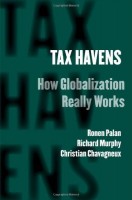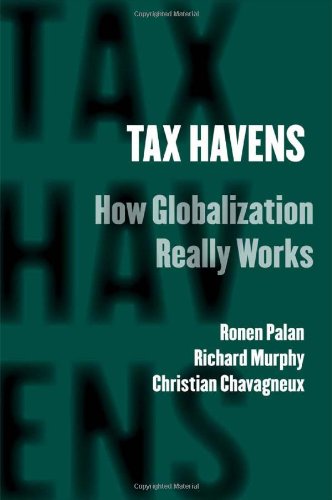 Editors: Ronen Palan, Richard Murphy, and Christian Chavagneux
Editors: Ronen Palan, Richard Murphy, and Christian Chavagneux
Publisher: Cornell University Press – 270 pages
Book Review by: Sonu Chandiram
We start the review of this book, published in 2010, by giving you a brief background about globalization. Globalization essentially, is global competition for economic benefits among countries. The benefits are multi-fold. Some of the benefits that countries get are:
- More capital to create new companies and expand existing ones
- More means of innovation to create new products, new companies, new jobs
- More jobs for its people to bring about higher standards of living
- More income for company owners, their employees and their families
- More taxes for government to foster development of the country
All of the above put together help increase the growth and importantly, the growth rate, of a given country’s gross domestic product. Both the public sector (the different levels of government) and the private sector (companies of all sizes) in a country can benefit from successfully competing in our globalized world.
What is happening in today’s world is that more capital, innovation, jobs, and income are flowing to more competitive countries, and less of these benefits to those countries that are not as competitive. There are structural imbalances in the economies of some countries that make them less competitive.
For example, the U.S. public sector, with three levels of government – Federal, state, and local – consumes more than 40 percent of the country’s GDP. The public sector does not only not create any new income, it consumes a whole lot of it produced by the private sector, making the country quite uncompetitive, with high taxes and high wages that result in higher prices for its products and services in the international market.
The BRICS – Brazil, Russia, India, China, and South Africa – are benefitting a lot, and have higher rates of GDP growth than other countries because they are attracting a lot of capital and the other benefits we’ve named above, whereas the Western world – Europe and the United States in particular – are attracting less of these than they did before.
I believe there are two main ways countries become less competitive. One of them is that when countries have high taxes – income, property, and sales taxes – they get smaller amounts of the benefits we have itemized. The other is relatively higher prices for goods and services compared with competing countries, which leads to smaller volumes of export, and therefore less money coming in to a given country from other countries.
This book has an apt subtitle using the word globalization. What is the reason there are tax havens? Why did they arise? And how can we make them non-existent? By removing the motives for their existence. I believe the root cause is high taxes in some countries.
The United States has one of the highest, if not the highest income tax rates for both corporations and individuals. Like other problems, the U.S. government deals with it by passing and enforcing laws against people who have assets overseas. The right way to deal with it I believe, is to lower tax rates: eliminate the reason for the emergence of tax havens. Treat the cause, not the symptoms.
This is a well-researched book by Palan, Murphy and Chavagneux on the uses, evolution, international political issues, and the ongoing emotional-intellectual conflict on tax havens. Here below is the organization of the material in four parts and ten chapters in this book as presented on its contents pag
Introduction
Tax Havens and their Uses
- What is a Tax Haven
- Tax Havens: Vital Statistics
- The Instruments of Tax Havens
The Evolution of Tax Havens
- Origins of the Tax Havens
- The British Empire Strikes Back
Tax Havens in World Politics
- Tax Havens and the Developed World
- Issues in Development
The Battle for Hearts and Minds
- Signs of Discontent
- Institutional Attacks on Tax Havens
- Tax Havens in the Twenty-First Century
Conclusion
We are not going to get into the details of the contents of this book; we have provided you an outline above that you can use as a guide to delve into any particular aspect of tax havens. There are also numerous tables and figures presented in this book that show you where the tax havens are located worldwide, banks and financial centers ranked by assets, and much more. This is an enlightening book and we congratulate its authors for this enlightening book. There is also a very useful glossary of unusually uncommon terms, many of which you most likely have not heard of.







